CASE DISCUSSION
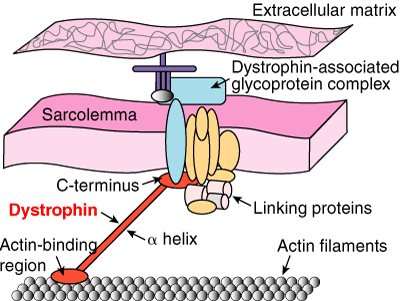 Dolly's male puppies were diagnosed with X-linked muscular dystrophy. This is a rather rare condition, analogous to the human ailment, Duchenne-type muscular dystrophy. While there are some differences between the human and canine diseases, the two are remarkably similar, enough so that some researchers feel the canine form is a useful animal model. MD isn't exclusive to Goldens, but it's more common in that breed than in others.
Dolly's male puppies were diagnosed with X-linked muscular dystrophy. This is a rather rare condition, analogous to the human ailment, Duchenne-type muscular dystrophy. While there are some differences between the human and canine diseases, the two are remarkably similar, enough so that some researchers feel the canine form is a useful animal model. MD isn't exclusive to Goldens, but it's more common in that breed than in others.
The specific defect in this condition is in the gene coding for production of dystrophin, a structural protein of the cytoskeleton that anchors intramuscular filaments to the plasma membrane. Dystrophin, an intra-cytoplasmic protein, is found just under the plasma membrane, linking the actin fibers of the cell to transmembranous sarcoglycans. The latter connect to dystroglycans and to laminin-2, a part of the basal lamina (extracellular basement membrane).
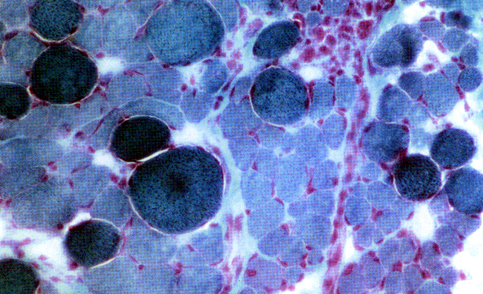 In MD, affected muscle cells begin to die because of damage to the membrane, and the anatomic muscles commence a series of cycles of degeneration and attempted renewal. Over time, the repeated necrosis and "repair" by proliferation of connective tissue and some fiber regeneration leads to scars in the muscles. All skeletal muscles are affected to some degree: in biopsies the fibers are described as "too large" or "too small" with both being present in the same section. The elevated CK, AST, and ALT are all signs of muscle injury. Dystrophin is also necessary for normal function of cardiac muscle, and the heart is affected as well as the skeletal musculature. Death occurs in severe cases by respiratory failure due to muscle weakness, inhalation pneumonia, and/or heart failure. There is as yet no treatment, but in human Duchenne's MD, some progress has recently been made using gene therapies.
In MD, affected muscle cells begin to die because of damage to the membrane, and the anatomic muscles commence a series of cycles of degeneration and attempted renewal. Over time, the repeated necrosis and "repair" by proliferation of connective tissue and some fiber regeneration leads to scars in the muscles. All skeletal muscles are affected to some degree: in biopsies the fibers are described as "too large" or "too small" with both being present in the same section. The elevated CK, AST, and ALT are all signs of muscle injury. Dystrophin is also necessary for normal function of cardiac muscle, and the heart is affected as well as the skeletal musculature. Death occurs in severe cases by respiratory failure due to muscle weakness, inhalation pneumonia, and/or heart failure. There is as yet no treatment, but in human Duchenne's MD, some progress has recently been made using gene therapies.
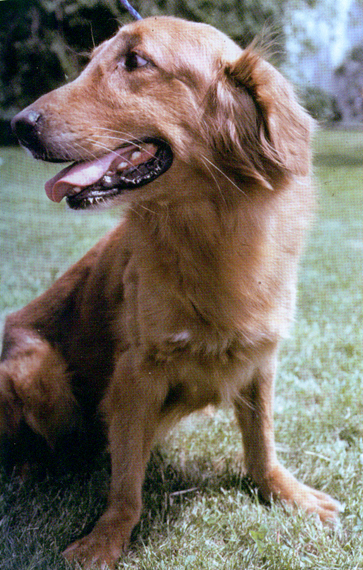
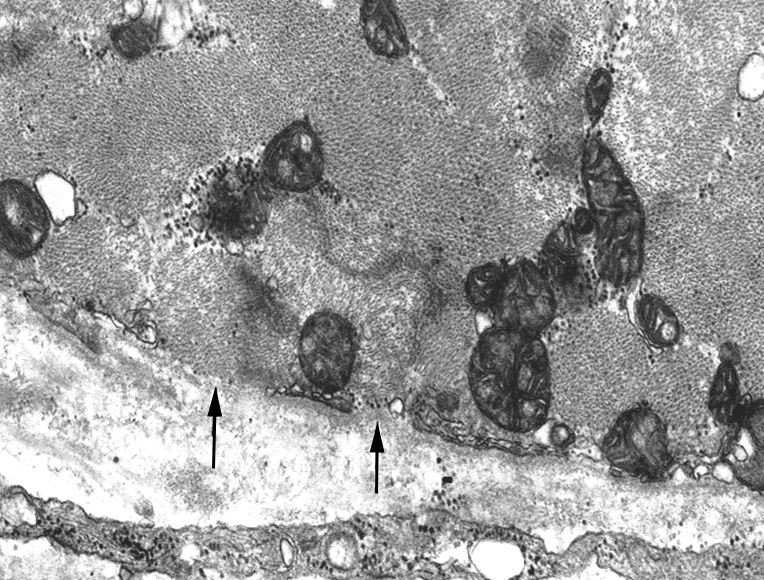 The image at right shows a male Golden with the condition. note the atrophied muscles, and outward rotation of the forelimbs. A biopsy from this dog would show a complete absence of dystrophin in his skeletal muscles, most likely. The comparative staining reaction, using an immune-labeling routine for dystrophin, shows that affected dogs have a complete absence of the protein from the peripheral regions of the skeletal muscle; carriers show a variable pattern of staining. In severe cases, the electron microscope (left) can actually show holes in the plasma membrane large enough for some mitochondria to pass through (arrows)! Obviously no cell can maintain its internal environment properly with membrane defects as severe as these.
The image at right shows a male Golden with the condition. note the atrophied muscles, and outward rotation of the forelimbs. A biopsy from this dog would show a complete absence of dystrophin in his skeletal muscles, most likely. The comparative staining reaction, using an immune-labeling routine for dystrophin, shows that affected dogs have a complete absence of the protein from the peripheral regions of the skeletal muscle; carriers show a variable pattern of staining. In severe cases, the electron microscope (left) can actually show holes in the plasma membrane large enough for some mitochondria to pass through (arrows)! Obviously no cell can maintain its internal environment properly with membrane defects as severe as these.
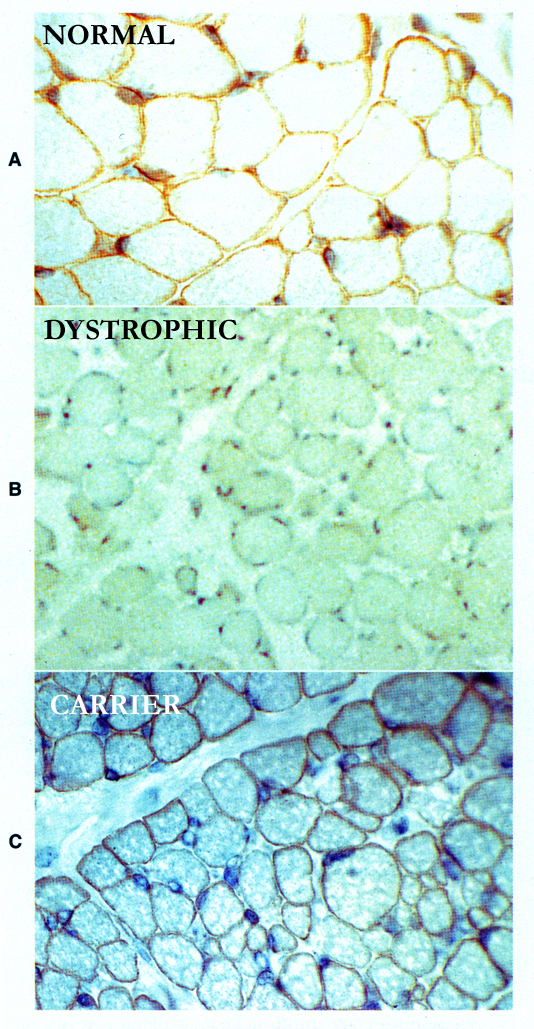 The clinical presentation of MD is similar to that of other musculoskeletal atrophies, so much so that definitive diagnosis can only be made through the use of staining for dystrophin in a biopsy, an expensive and painful procedure few owners are willing to authorize. X-linked MD is also a pretty rare condition, not often encountered.
The clinical presentation of MD is similar to that of other musculoskeletal atrophies, so much so that definitive diagnosis can only be made through the use of staining for dystrophin in a biopsy, an expensive and painful procedure few owners are willing to authorize. X-linked MD is also a pretty rare condition, not often encountered.
As with Duchenne's MD in humans this recessive mutation only presents clinically in males. Dolly's a carrier, but because females are XX, she has a normal dystrophin gene on her other X chromosome to balance it off. Any female whose offspring show signs of MD is a carrier, and breeders are quick to weed those out of the breeding pool, as Dolly's first owner did.
Approximately half the male offspring of female carriers will be affected, because males have only one X chromosome and there's no counteracting dystrophin gene on the Y chromosome of males. The degree of expression of the defect is variable: one of Dolly's male pups died early because his condition was more severe than his littermate's, but both were affected.
As to the females in the litter: if Dolly's breeder ran her business properly, she'd have insisted that these bitches be spayed before agreeing to a sale. At the very least, she should contact the buyers, inform them of the fact that their pets are carriers, and urge them to spay if they hadn't done so already. one reason this condition isn't very common is because breeders are quick to weed out the gene from their bloodlines, either by spaying or euthanizing. Dolly's first owner opted for the first, followed by a quick adoption.
References:
McGavin, M.D., and J.F. Zachary. 2007. "Congenital or Inherited Myopathies" IN: Pathologic Basis of Veterinary Disease (4th Edition). Mosby/Elsevier (St. Louis). ISBN 13-978-0-323-02870-7. Pp. 1026-1027.
Cozzi, F., M. Cerletti, G.C. Luvoni, R. Lombardo, P.G. Brambilla, S. Faverzani, F. Blasevich, F. Cornelio, O. Pozza, and M. Mora. 2001. Development of muscle pathology in canine X-linked muscular dystrophy. II. Quantitative characterization of histopathological progression during postnatal skeletal muscle development. Acta Neuropathologica 101: 469-478.
Cooper, B.J., B.A. Valentine, S. Wilson, D.F. Patterson, and P.W. Concannon. 1988. Canine muscular dystrophy: Confirmation of X-linked inheritance. Journal of Heredity 79: 405-408.
 Dolly's male puppies were diagnosed with X-linked muscular dystrophy. This is a rather rare condition, analogous to the human ailment, Duchenne-type muscular dystrophy. While there are some differences between the human and canine diseases, the two are remarkably similar, enough so that some researchers feel the canine form is a useful animal model. MD isn't exclusive to Goldens, but it's more common in that breed than in others.
Dolly's male puppies were diagnosed with X-linked muscular dystrophy. This is a rather rare condition, analogous to the human ailment, Duchenne-type muscular dystrophy. While there are some differences between the human and canine diseases, the two are remarkably similar, enough so that some researchers feel the canine form is a useful animal model. MD isn't exclusive to Goldens, but it's more common in that breed than in others. 

 The image at right shows a male Golden with the condition. note the atrophied muscles, and outward rotation of the forelimbs. A biopsy from this dog would show a complete absence of dystrophin in his skeletal muscles, most likely. The comparative staining reaction, using an immune-labeling routine for dystrophin, shows that affected dogs have a complete absence of the protein from the peripheral regions of the skeletal muscle; carriers show a variable pattern of staining. In severe cases, the electron microscope (left) can actually show holes in the plasma membrane large enough for some mitochondria to pass through (arrows)! Obviously no cell can maintain its internal environment properly with membrane defects as severe as these.
The image at right shows a male Golden with the condition. note the atrophied muscles, and outward rotation of the forelimbs. A biopsy from this dog would show a complete absence of dystrophin in his skeletal muscles, most likely. The comparative staining reaction, using an immune-labeling routine for dystrophin, shows that affected dogs have a complete absence of the protein from the peripheral regions of the skeletal muscle; carriers show a variable pattern of staining. In severe cases, the electron microscope (left) can actually show holes in the plasma membrane large enough for some mitochondria to pass through (arrows)! Obviously no cell can maintain its internal environment properly with membrane defects as severe as these.